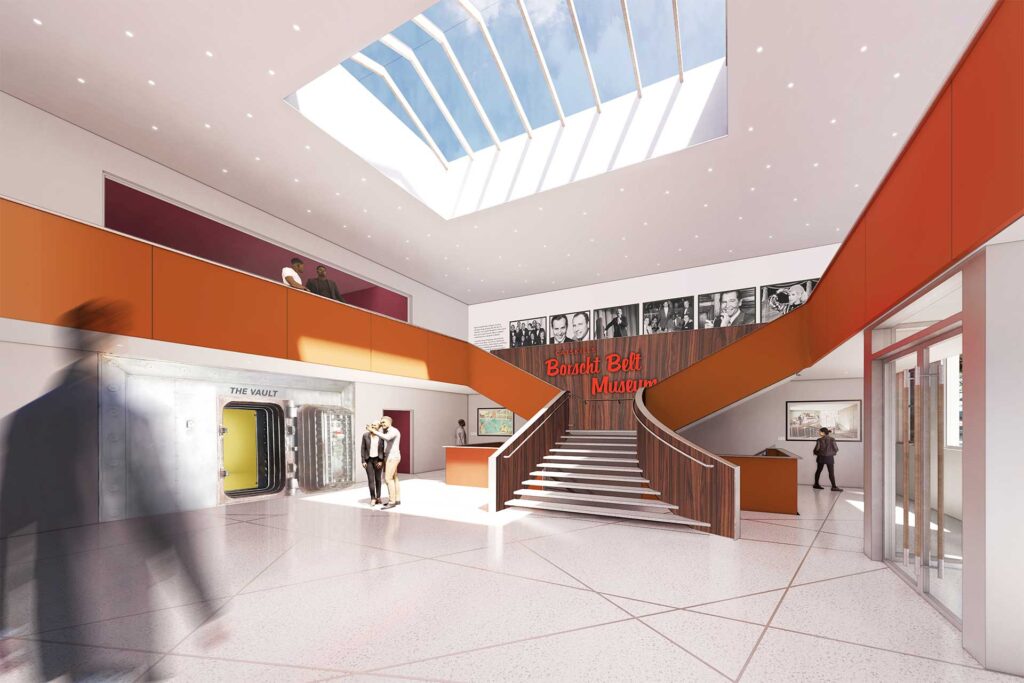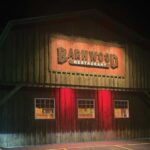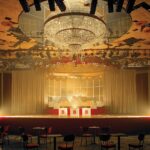Comic past is serious business as 2025 opening looms.
By Tara Solomon
Growing up in Miami Beach during the 1960s & ’70s, my best friend Susan Whitebrook spent three to four weeks every summer at the tony Concord in the Catskills, where she learned to dance the hustle and had her first kiss—an innocent peck on the lips with a young waiter working his way through college named Gary, when she was sweet 16.
(And, no, it didn’t happen at clandestine staff quarters as depicted in Dirty Dancing, although the guest-employee romance was certainly a thing, Susan recalls, adding that she also slow-danced to “The Lady in Red” with another young waiter, Teddy, at the hotel’s Night Owl Lounge. Teddy had a twin brother, Susan shared, but we didn’t press for details.)
Everyone, it seems, has a Borscht Belt story—indelible memories of their summer happy place. Overlooked and forgotten since the area’s decline in the mid-1980s, the Borscht Belt is making its big comeback—with a museum of its own, slated to open spring 2025, and an annual festival celebrating the Borscht Belt vibrant lifestyle starting this summer.
“The Borscht Belt was an incredibly important part of American culture,” says Andrew Jacobs, president of the board of directors of the new Catskills Borscht Belt Museum. “By honoring its legacy, we’re honoring Jewish culture and the many individuals who created what’s one of the nation’s most dynamic and unique eras.”
Housed in the former Home National Bank building in Ellenville, NY—a neo-Georgian, brick-and-terracotta structure from 1928 that’s on the National Register of Historic Places—the museum’s location is especially significant: The bank was one of the first to lend money to the region’s Jewish hoteliers.
Originally a resort destination for gentiles in the 19th century, the Catskills started becoming a destination for Jewish emigres and city dwellers in the 1920s. Enticed by the clean mountain air, pristine lakes and homecooked traditional meals, Jews found a safe haven where they could escape both the stifling heat and the nation’s prevailing antisemitism.

During its heyday in the 1950s and ’60s, there were nearly 1,000 hotels, boarding houses and bungalows catering to Jewish families. Dubbed “The Jewish Alps,” the Catskills boasted upscale resorts such as the Nevele, Grossinger’s, Brown’s, Laurel’s and Kutsher’s that featured amenities lavish even by today’s standards—professional golf courses, tennis courses, indoor pools, skating rinks–even a ski slope with imported snow and a fancy chalet.
The glitzy, Vegas-style hotel theaters hosted nightly performances by showbiz elite, including Judy Garland, Louis Armstrong, Johnny Mathis, Tom Jones, Engelbert Humperdinck and Paul Anka, as well as the famed comedians who helped give the Borscht Belt its name: Don Rickles, Milton Berle, Fanny Brice, Rodney Dangerfield, Jerry Lewis (who had his own theater at Brown’s) and, of course, Henny “Take My Wife, Please” Youngman.
Massive and flashy, Catskills venues had fanciful names such as Stardust Nightclub (Kutsher’s), Starlight Room (Stevensville Hotel) and Black Magic Room (Commodore Hotel) and accommodated up to 3,000 guests.
A forerunner of the all-inclusive vacation, a stay in the Catskills guaranteed a summer full of fun and adventure—for one lump sum. The bungalow colonies, or kuchalane—Yiddish for “cook alone”—were geared to the middle class, offering a flexible option for families whose breadwinner needed to drive back to the city for the work week. “It’s fair to say that a garment worker or taxi driver could afford a few weeks at a kuchalane,” says Jacobs.
This fascinating, historically rich melting pot of Jewish society and customs will be celebrated at the upcoming Catskills Borscht Belt Museum through visiting exhibitions as well as a core collection of photography, original hotel brochures and other memorabilia, films, audio recordings of personal recollections and educational materials. “It’s essential for future generations to understand the importance of this time,” says Jacobs.
In advance of the museum’s opening in spring 2025, organizers will be debuting the Borscht Belt Fest, an annual cultural and food event, July 29-30 in Ellenville, NY. A curated street fair will feature vendors selling tasty noshes, and Master of Simon Sez, Steve Max, will lead a group of that Borscht Belt staple. Five local bands will perform, including one that plays nothing released after 1967. The special guest of honor will be iconic Catskills painter Morris Katz. “Every Jewish family had one of his Dancing Rabbi paintings,” says Jacobs.
The festival is free and open to the public; the five comedy shows and panel talks will both require a ticket.
“Part of our mission is to show people the Catskills is cool again,” says Jacobs. “After 50 years, it’s ready for its second act Susan Whitebrook and I will see you there in our search for Mrs. Maisel and her intoxicating brand of nostalgia mixed with humor so perfectly reflective of the magic in the mountains known as the Borscht Belt. Mazel to one and all.















Comments are closed.